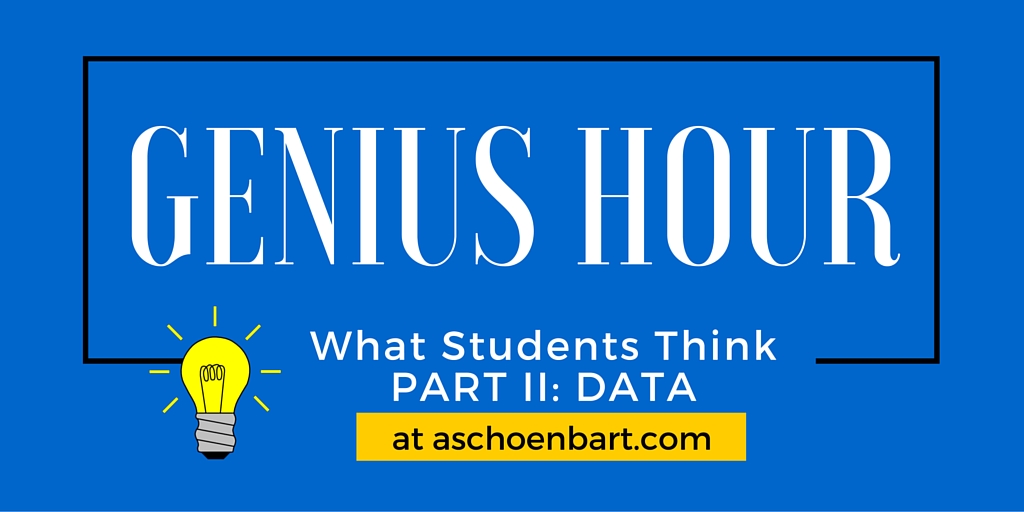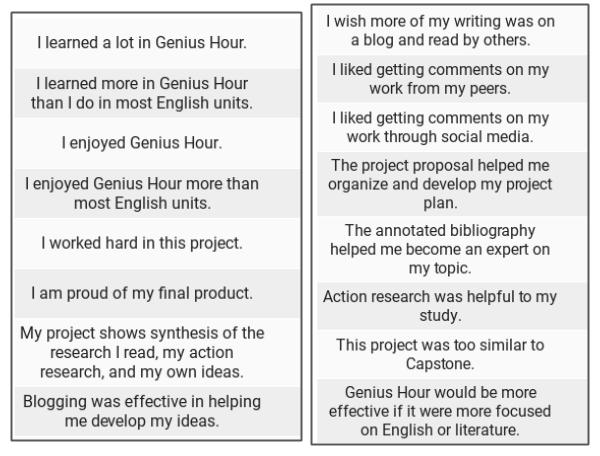What Students Think About #GeniusHour Part 2: Data


Last week, I wrote about my students’ written reflections and self-evaluations for their #GeniusHour projects. Students evaluated themselves on a rubric and answered a series of questions examining their growth, process, and project. Read #GeniusHour: What Students Think to learn all about students’ perspectives on passion-based learning.
The last step for the reflection was a brief Google Form, evaluating the project itself--basically evaluating my planning and instruction. I wanted to use a Doc in Google Classroom for the reflections to focus on qualitative writing but decided to split the project evaluation into a Google Form grid for some quick analysis.
This qualitative data is really interesting for me. In this article, I will share charts from the summary of responses, detailing their views on #GeniusHour, with some very brief commentary. I love the combination of the open-ended Google Docs with the closed Google Forms to be able to value student voice and reflection, and manage the workflow easily.
Find more of my recent writing on Genius Hour with Redesigning Learning Spaces, Sharing Students’ Genius: A #GeniusHour Reflection, Developing Genius: Reflecting on Choice, Passion, and #GeniusHour, Teaching Students to Conduct Action Research, and My Questions About #GeniusHour. For my students’ blogs and work, visit geniushour.aschoenbart.com.
The Form
Students found the link to the form at the end of their Reflection Docs as the last part of the assignment. The directions state:
The purpose of this form is to evaluate how all of my students liked and learned from Genius Hour as a whole. What works with Genius Hour? What doesn't? How can I make it better?
Please note that I will share the data from these responses in my own writing but your names and details will not be shared.
Tools and ideas to transform education. Sign up below.
Then, I created a simple list of statements in a grid question and asked students to select strongly agree, agree, disagree, or strongly disagree. Here is a screenshot of those statements:

Finally, I asked: Do you have any final questions or comments about Genius Hour? This question was optional and most chose not to add comments here. With the length and detail of their reflection docs, that was fine with me.

Right now, I’m the only teacher in my school using #GeniusHour or a similar passion-based framework. I hope that will change soon, and I’ve had some interest from other teachers, but I wonder about how that impacts my students’ perceptions. They know they learned--and that’s great--but I’m glad I asked about their perceptions about the projects in comparison to the more traditional English class. It makes me want to up my game in my non-Genius Hour instruction, but validates the growth I’ve seen, too.


They learned, but did the enjoy? Mostly. Some students struggled and I know that many hated parts of it--the research, the annotated bibliographies, and for some, the presentations. But those number show that in the end, they learned and enjoyed, overall. Victory!


Back in September, I always told students that I wanted them to leave the year with more than crumpled up essays in the bottom of their backpacks. I wanted them to learn and create, and to be proud of what they achieve. These numbers represent what I saw in class--and now I need to do more to help guide the 24% of disagreers towards doing something to really be proud of. I reflected on issues like this inMy Questions About #GeniusHour.

Ah, synthesis: one of the big concepts I will do better with next time. I want my students to be able to take what they’ve learned and researched and use it to create something new. That’s a big task, and something I need to focus on more explicitly.





I could write a whole other article about blogging in Genius Hour. And maybe I should. Blogging is a great way to help students develop their voices, track their growth, and develop their plans. But so many student didn’t see the value in it. Even when I often did, that’s not enough. 54% did not find blogging to be effective and yet 73% liked getting comments from peers and 65% on social media.
I have to figure out how to bridge that gap and make blogging more meaningful for those students. I might consider scheduling students’ blog posts less often, and rotate a schedule so they putting out new content and reflections less often, in more depth, and at different times. This way, they can always learn from and comment on each other’s work while reducing the pressure for their own writing.


These responses relate directly to the more formal written aspects of the project. I’m glad students found value in the proposals and action research. Since the annotated bibliographies were the most prescribed part of the project, I wonder if they’re really questioning their expertise or enjoyment of documenting their research.


In these two questions, I’m looking for data for the future. My tech coaching position is for a program called Capstone, which has some similarities with Genius Hour. My students are working on that, too, and I worry about the overlap. I’ve considered adjusting the project to make it more focused on English class or literature. But while the similarities were an issue for students, they don’t seem to like that idea. And honestly, I’m not sure that I do, either.

The Big Picture
Data can play a powerful role in driving instruction when it’s used right. This data is essential for my growth as a teacher: it will help me do better next year and to create a culture of better learning experiences for my students.
Next week, I’ll share some highlights of this year’s learning with some student projects from #GeniusHour. That will likely wrap up this series for now, but the more I write, the more the ideas are coming.
What do YOU think about #GeniusHour or passion-based learning? How do you use data for reflection or to drive instruction? Share your thoughts in the comments below or on Twitter.
cross posted at www.aschoenbart.com
Adam Schoenbart is a high school English teacher, Google Education Trainer, and EdD candidate in Educational Leadership. He teaches grades 10-12 in a 1:1 Chromebook classroom at Ossining High School in Westchester County, NY and received the 2014 LHRIC Teacher Pioneer Award for innovative uses of technology that change teaching and learning. Read more at The SchoenBlog and connect on Twitter @MrSchoenbart.
